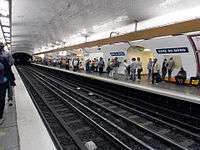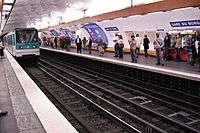Gare du Nord (Paris Métro)
Gare du Nord (French: [ɡaʁ dy nɔʁ]) is a station on Line 4 and Line 5 of the Paris Métro. It is the busiest station in the system (not including RER stations), with 48 million entrances a year. It is connected to the SNCF railway station Gare du Nord (literally, "North Station", until 1938 run by the well-known company Chemins de Fer du Nord), which is served by RER B, RER D and Transilien Nord commuter trains as well as interurban trains to northern France, Eurostar trains to London and Thalys trains to Brussels, Amsterdam and Cologne. The station is also connected to the La Chapelle Métro station on Line 2 and to the Magenta RER station on RER E.
| Paris Métro station | |||||||||||||||||||||||||||||||||
 Line 4 platforms at Gare du Nord | |||||||||||||||||||||||||||||||||
| Location | 9, Boul. Denain 17, Rue de Dunkerque 18, Rue de Dunkerque Gare du Nord 10th arrondissement of Paris Île-de-France France | ||||||||||||||||||||||||||||||||
| Coordinates | 48°52′50″N 2°21′18″E | ||||||||||||||||||||||||||||||||
| Owned by | RATP | ||||||||||||||||||||||||||||||||
| Operated by | RATP | ||||||||||||||||||||||||||||||||
| Other information | |||||||||||||||||||||||||||||||||
| Fare zone | 1 | ||||||||||||||||||||||||||||||||
| History | |||||||||||||||||||||||||||||||||
| Opened | 15 November 1907 | ||||||||||||||||||||||||||||||||
| Services | |||||||||||||||||||||||||||||||||
| |||||||||||||||||||||||||||||||||
| |||||||||||||||||||||||||||||||||
| Location | |||||||||||||||||||||||||||||||||
 Gare du Nord Location within Paris | |||||||||||||||||||||||||||||||||
History
.png)
On 15 November 1907, Line 5 was extended from Gare d'Orléans (now known as Gare d'Austerlitz) to Gare du Nord where the station was built on a reversing loop. On 21 April 1908, Line 4 was opened from Châtelet to Porte de Clignancourt through Gare du Nord.
On 5 October 1942, the old Line 5 station was closed and replaced with a through station on 12 October 1942, in preparation for the extension to Église de Pantin. The part of the old loop that was not destroyed during the building of RER B in the 1970s, together with connecting lines to Line 2 and Line 4 under the Boulevard de Magenta and Rue de Dunkerque, are now used for driver training (USFRT). The length of platforms on Line 4 were extended from 75 metres to 90 metres in the 1960s during the upgrading of the line for rubber-tyre operations.
On 10 December 1981, the RER B station at Gare du Nord opened. The RER D station opened on 27 September 1987 with the rest of the line, while Gare de Magenta on the RER E line opened on 14 July 1999. The Church of Saint-Vincent-de-Paul is located nearby.
Passenger services
Access
Access to the station, designed in 1900 by the architect Hector Guimard of the Compagnie Générale du Métropolitain de Paris, has been listed as a historic monument since 29 May 1978.
It has four entrances:
- Entrance: 9, Boulevard de Denain;
- Entrance: 17, Rue de Dunkerque;
- Entrance: 18, Rue de Dunkerque;
- Entrance: SNCF station.
Station layout
| Street Level |
| B1 | Connecting level |
| Line 4 platforms | Side platform, doors will open on the right | |
| Northbound | ← | |
| Southbound | | |
| Side platform, doors will open on the right | ||
| Line 5 platforms | Side platform, doors will open on the right | |
| Southbound | ← | |
| Northbound | | |
| Side platform, doors will open on the right | ||
Platforms
The stations of the two lines are of a standard configuration: they include two platforms flanking two tracks under an elliptical vault. However, the Line 4 station also has a later extension, recognizable by its much higher ceiling and mezzanine.
The platforms of Line 5 are decorated in the Andreu-Motte style: the fittings are orange, but the tiles are white and beveled. The advertising frames are metallic and the name of the station is indicated on enamelled plates, in Parisine font. Line 4 platforms are under construction and platform screen doors are being installed from September 2019.
Bus and RER connections
From the station, it is possible, thanks to underground links, to reach the RER B and RER D lines, the Gare de Magenta of the RER E and the La Chapelle of the Line 2.
The station is served by lines 26, 31, 35, 38, 39, 43, 45, 46, 48, 54, 56, 91, 302 and the OpenTour tourist line of the RATP Bus Network and, at night, by lines N01, N02, N14, N43, N44, N140 and N143 of the Noctilien network.
Gallery
 Street-level entrance to Gare du Nord
Street-level entrance to Gare du Nord Line 5 platforms at Gare du Nord
Line 5 platforms at Gare du Nord MF 67 rolling stock on Line 5 at Gare du Nord
MF 67 rolling stock on Line 5 at Gare du Nord Platform signage
Platform signage
| Wikimedia Commons has media related to Gare du Nord (Paris Metro). |
See also
- Gare du Nord
- Gare de Magenta
References
- Roland, Gérard (2003). Stations de métro. D’Abbesses à Wagram. Éditions Bonneton.